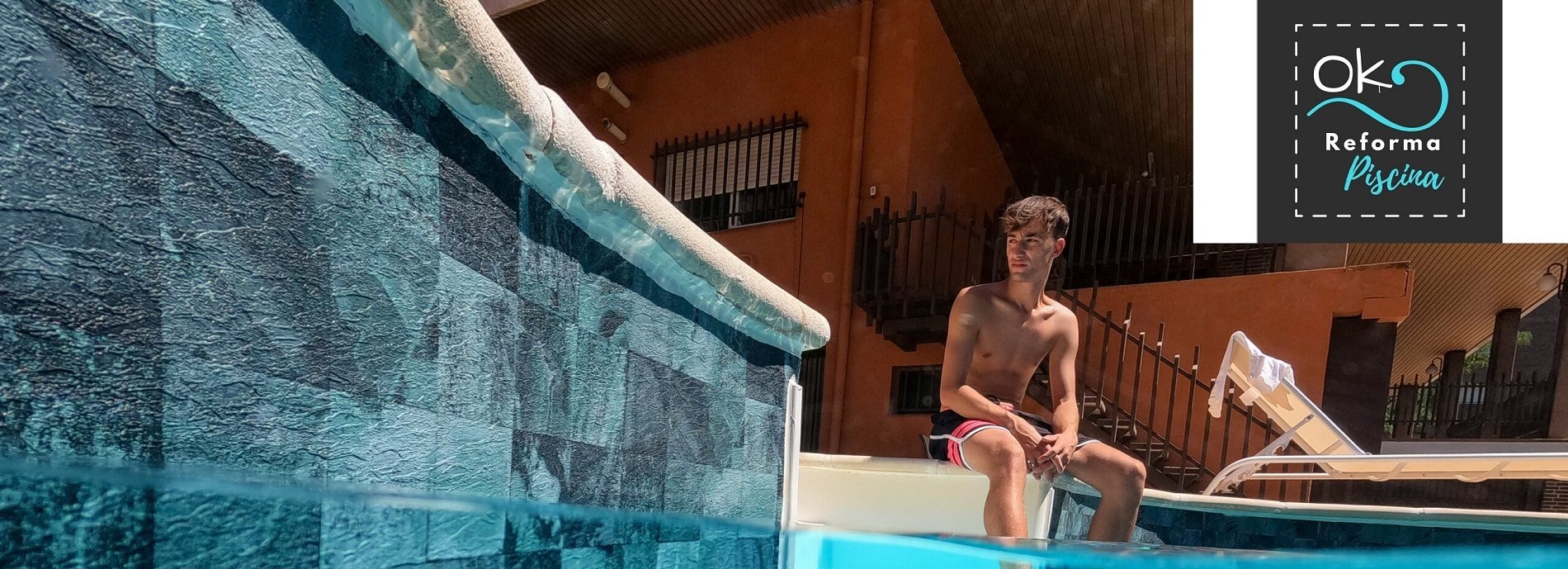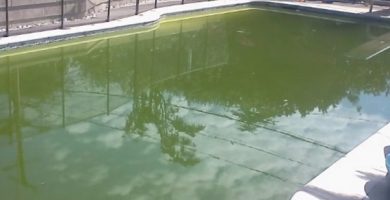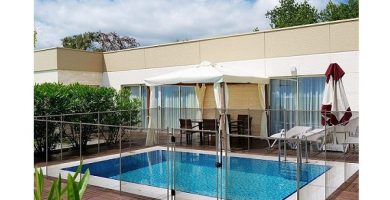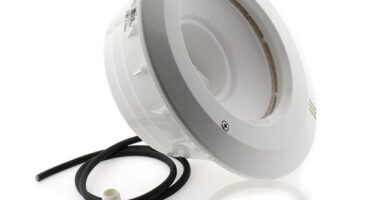
Table of contents of the page
How can I maintain safety in swimming pools?

Swimming pool regulations, standards and safety tips
What are frogs?
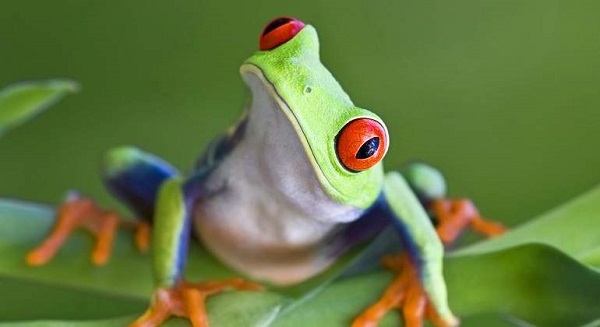
What are frogs?
Frogs are animals within the group of amphibians.
Frogs, also known colloquially as toads, are small anuran amphibian vertebrates that live in humid areas or areas associated with water., which have a short and very widened body that does not have an adult tail, and highly developed hind legs adapted for jumping.
What are frogs like?

These are the main characteristics of frogs:
- Class: amphibian
- Length: between 6 and 10 cm
- Weight: between 20 and 80 grams
- Longevity: 10 and 12 years between
- Maturity: 1 and 4 years between
- Reproduction: oviparous
- Young per clutch: between 80 and 3.000 pups
- Incubation: 3-20 days
- Habits: day/night
- Feeding: insectivorous/carnivorous
- Character: peaceful, calm and docile (not all)
green frogs
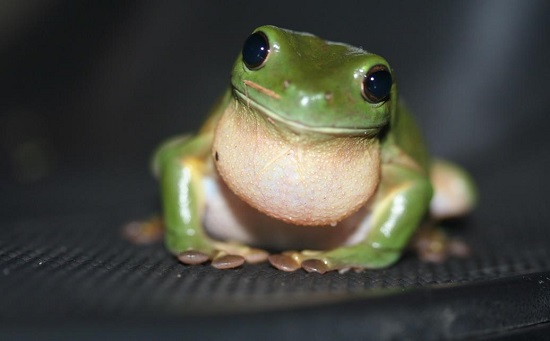
Why are frogs green?
Proteins called serpins bind to the pigment and adjust the amphibian's coloration. For most animals, high concentration of biliverdins is a bad sign
Taxonomy of Frogs
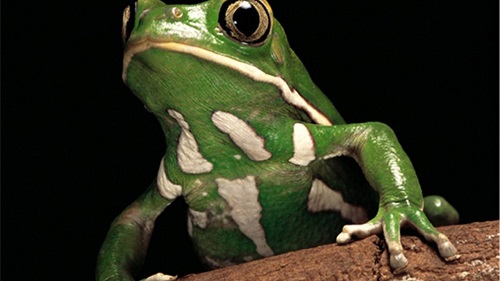
Naming of frogs
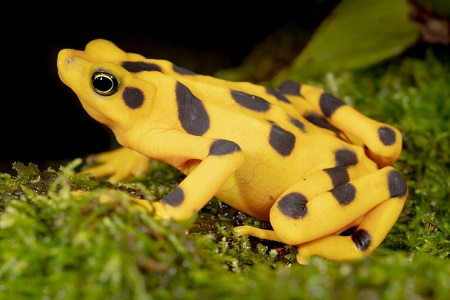
Scientific name of the frog: Anura
Where does the frog's scientific name Anura come from?
The scientific name of the frog Anura is derived from ancient Greek ἀ(ν-) a(n-) (negation) and οὐρά oura 'tail', meaning 'tailless'
Colloquial name: Frogs or toads
What is referred to by the names of frogs and toads?
- In general, people tend to associate frogs and toads as if they were the same species of amphibians and, in fact, the two terms are currently used in indiscriminate and arbitrary ways.
- However, even though they have certain similarities as animals, there are really differences between them.
Differences between frogs and toads
Characteristics to identify a frog from a toad
What is the scientific name of the common frog?
- On the one hand, there is the common frog who has the scientific name: Pelophylax perezi.

Peculiarities to distinguish a frog from a toad
- To begin with, it is worth mentioning that we can differentiate between a toad and a frog because these are the most graceful species, with moist and smooth skin, good jumpers, and climbing or aquatic habits.
Representative qualities to discern a toad from a frog
Scientific name of the common toad: Bufonidae or bufo bufo
- On the other hand, typical toads (those of the Bufo genus) also coexist;
- In this way, the bufo is a genus of anuran amphibians of the family of the buffoons (Jester) are a family of the order Anura, a group of known amphibians.
How to discriminate from a toad to a frog
Distinctive features of the common toad:
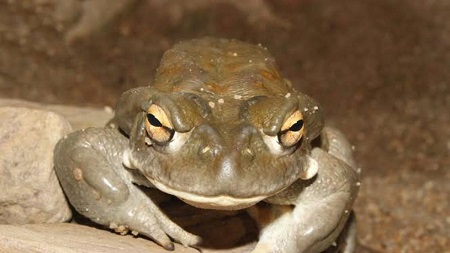
Above all, to determine if it is a toad, we will look at the following attributes:
- Chubby, warty and very robust body in adult specimens.
- Reddish or copper colored eyes with horizontal pupil.
- Parotid glands very developed and oblique (they are almost parallel in the frog runner).
- Ground color brown, yellowish, reddish or grayish, sometimes with spots, but without a clear dorsal band.
What kind of animal is the frog?

The frog belongs to the class Amphibia, amphibians
- The frog is an animal that belongs to the amphibian group and, along with toads, is part of the anuran group.
What does it mean to be amphibious?
Amphibians are a class of anamniote, tetrapod, ectothermic vertebrate animals, with gill respiration during the larval phase and lung respiration when reaching the adult state. Unlike the rest of vertebrates, they are distinguished by undergoing a transformation during their development.
Classification of amphibians
Next, we present Amphibians are therefore classified into 3 groups according to body shape:
Anuran Amphibians

What are urodele amphibians and what are their characteristics?
- First of all, anurans are the category of amphibians that do not have tails.
- This group is characterized by their Individuals lack a tail, have a short and very widened body, and have more developed hind legs, adapted for jumping.
What are anuran amphibians?
- Within the group of Anura amphibians (Salientia) we find frogs and toads.
Urodele Amphibians

What are urodele amphibians and what are their characteristics?
- Secondly, Urodele amphibians are amphibians with an elongated body, bare skin and glands, sometimes poisonous, and equipped with a tail.
- These animals are older than frogs and toads, and are the amphibians most closely linked to the aquatic environment.
- The larvae and adults are similar to each other and are aquatic. Sometimes adults retain the gills due to lack of complete development.
- They have equal legs and some species have atrophied rear legs.
What are urodele amphibians?
- At the same time, They are urodele amphibians, animals such as: salamanders, newts, axolotls, mole salamanders, lung salamanders, Olympic salamanders, giant salamanders, Asian salamanders, amphiumas and proteids.
Amphibians Gymnofiones

What are gymnofion amphibians and what are their characteristics?
- Ultimately, the amphibians Gymnofiones or Gymnophona or also called Cecilias are large legless amphibians, shaped like a worm.
- Mainly from humid tropical regions, exhibiting a fossorial lifestyle by living underground.
- From a close-up view, these limbless amphibians look like small cobras.
- The large eggs are laid in cavities excavated in moist soil.
- Finally, note that some specimens reach one meter in length, as happens with certain American caecilians.
What are urodele amphibians?
- Meanwhile, in the caecilian group there are 200 species of amphibians with a gopher-like appearance and a vermiform appearance, that is, with elongated and cylindrical shape. , as an example: the blind viper.
- How can I maintain safety in swimming pools?
- What are frogs?
- Taxonomy of Frogs
- Why do we need to protect frogs?
- Why shouldn't you have frogs in the pool?
- Avoid accidents with frogs and other animals in the pool
- Avoid accidents with the escape ramp save animals
- Inflatable frog pool
- pool toy frog
How many species of frogs are there in the world?

How many types of frogs live on the planet?
- Currently, the Anurans are the largest group of amphibians; It is estimated that there are about 6608 species.
- In particular, the species in question are divided into 54 families of Anurans, of which about 5.500 are Anurans (frogs and toads -without adult tails-), 566 are urodeles (newts and salamanders -with adult tails-), and 175 are Cecilias or Cecilidae (subterranean amphibians).
Classification of frog families

Most unique variety of frogs in the world
Video of the 7 most exceptional species of frogs
RANAS Taxonomy Concepts

Scientific description sheet of frogs
| RANAS Taxonomy Concepts | Scientific description of frogs |
|---|---|
| Reino | Animals: Multicellular, heterotrophic organisms. |
| subkingdom | Eumetazoa: Organisms with tissue organization. |
| Domain | Eukaryota, eukaryote. organisms with eukaryotic cells |
| Class | Anura, anurans, amphibia, amphibians The frog is an animal that belongs to the group of amphibians. and, along with toads, it is part of the anuran group. Anurans are the largest group of amphibians; It is estimated that there are about 6608 species, divided into 54 families. |
| Subclass | Tetrapod: Tetrapods. Four limbs, although some species have lost organs during their evolution (vestigial organs), for example snakes. |
| Wire | Chordata: Animals with a notochord at least in some phase of their development. |
| Subphylum | Vertebrata: They have a spinal column. The frog is a vertebrate animal, which has hands, feet, bones and muscles like people and other vertebrates such as dogs, cats, snakes, birds, fish... |
| From | Eurasia and North America. |
| Habitat | Where do frogs usually live? Most spend their lives in or near water. |
| Time of life | How many years do frogs live? Frogs have an average lifespan of between 10 and 12 years, although frogs in captivity can live longer if they have a good quality of life. |
| Size | How tall are frogs? Normally, frogs usually measure Their size can vary from a mere 8,5 mm, as is the case of species of the genus Eleutherodactylus, to sizes that exceed 30 cm, highlighting the goliath frog, the largest anuran in the world. |
| Weight : | How much do frogs weigh? Usually, frogs weigh between 20 – 80g. |
| Color | What color are frogs? Y there are frogs of many colors, although they are usually green or brown in the Iberian Peninsula. But there are infinite patterns and colors all over the world (except in Antarctica). |
Stages Life cycles of frogs
Life cycle of a Frog
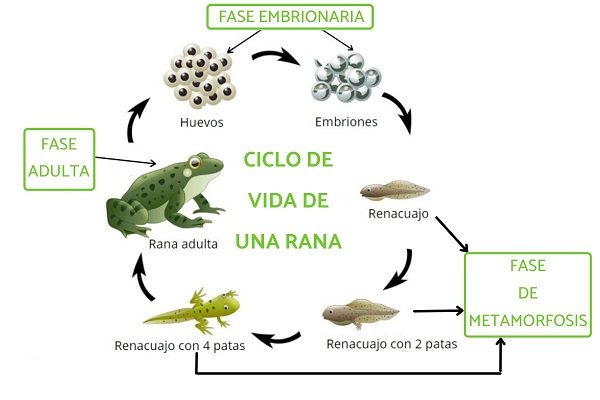
Phase of the life cycle of frogs
- G0 Phase- First days of life (up to 1 gram), it feeds on microorganisms (bacteria, fungi, algae) floating (planktonic) or attached to vegetation and other substrates (periphyton). On frog farms, they gradually begin to receive powdered feed.
- G1 Phase- Growth phase, where metamorphosis has not yet begun. At this stage, in some species of frogs, lung development already occurs, which makes it possible for the tadpole to breathe when it comes to the surface.
- G2 phase – Metamorphosis begins: the limbs develop and can already be seen as two small appendages on the back of the body.
- G3 phase– The hind legs are now almost completely exteriorized, but are not yet completely formed. Pre-metamorphosis begins.
- G4 phase– The tadpoles approaching the climax of metamorphosis. The four legs are completely ready; The posterior ones already have the shape of the adults' legs.
- G5 Phase- It is the climax of the metamorphosis. In this phase, the front legs are exteriorized. The tail, still large, sharpens, and is absorbed, little by little, supplying energy for the animal, which, meanwhile, does not feed. The main changes that occur during the climax of metamorphosis are related to breathing, circulation, digestion, sense organs (smell, vision) and limbs.
Explanation of the life cycle of frogs
Next, in the video we explain what the life cycle of frogs consists of and what its stages are.
What is frog metamorphosis?
And like almost all amphibians, frogs metamorphose, that is, they go changing shape from birth to adulthood

The newly metamorphosed frog leaves the aquatic environment to live in the terrestrial environment
- It has a body shape completely similar to that of an adult, but is sexually immature. The changes are intense.
- While in the aquatic phase the respiration was gill and the heart was similar to that of fish, with two cavities, in the terrestrial phase the heart will have three cavities and respiration, in addition to lung and skin, will take place in the region of the dewlap, where hematosis occurs, thanks to the great vascularization in this region and the oscillatory movements, when the frog periodically inflates and deflates the dewlap.
- The digestive system will also change, because the food that the tadpole consumes, in the aquatic environment, is generally made up of algae, bacteria, fungi and other microorganisms, which are found in the substrates and in the aquatic environment. In the terrestrial phase, they feed on insects, crustaceans, annelids, mollusks and small vertebrates.
How frog reproduction works

Fertilization is external
- (1). The fertilized eggs They settle in water and are fixed with mucous substances
- (2) . These are eggs with a permeable shell that would dry out in the air. After 2 or 3 months, the larvae called tadpoles, that breathe for gills, lack limbs and move through a tail (
- 3). Afterwards, they experience a metamorphosis: the tail is reduced, the four legs appear, the gills disappear (
- 4) and the lungs are formed, so individuals can now leave the water (5).
Desired breeding sites for frogs
To reproduce, they prefer small lakes or puddles, where they will give rise to tadpoles. For frogs to reproduce, they must reach sexual maturation and be in an environment with favorable conditions.
Why do we need to protect frogs?

Danger of extinction of frogs
Approximately 40% of frog species are at risk of extinction globally.
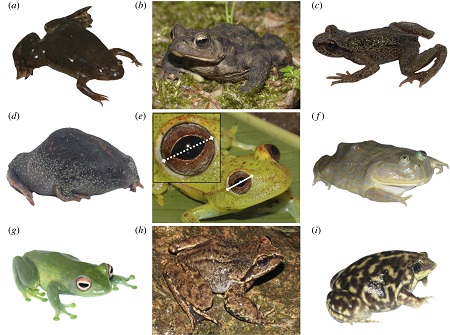
The main threats they face are related to habitat loss or deterioration, pollution, invasive species, overexploitation, infectious diseases, as well as climate change.
Thus, the protection of amphibians is an urgent task, since their function in nature is of great relevance for the balance of the ecosystem, and given their ecological and biological characteristics, amphibians contribute to human well-being in essential areas such as health. and food, among others.
In 2004, after carrying out a global assessment of amphibians, the World Conservation Union reported that between a third and a half of amphibians are in danger of extinction, and that some 120 lineages of these species are already They have disappeared from the planet.
Extinct Frogs
Frogs and amphibians (in general) are endangered – worldwide, almost a third of the world's amphibian species are on the brink of extinction. And yet, frogs contribute to our well-being in many important ways. Kerry Kriger M. describes why frogs are in trouble and how you can help save them. Lesson by Kerry Kriger M., animation by Simon Ampel.
International Frog Day
International Day for Amphibian Conservation

- Given so many threats to this fauna, the International Day for Amphibian Conservation is celebrated on the last Saturday of April every year. to denounce to the world the serious danger of these cold-blooded animals disappearing, due to the loss of their habitat, toxic waste, pollutants and climate change.
On March 20, the world's frogs are celebrated on Save The Frogs Day.
- Moreover, March 20 is World Frog Day, which was created in 2009 to raise awareness about the plight of threatened frog species around the world.
Why do frogs need to be saved?
They play an important role in the food chain.
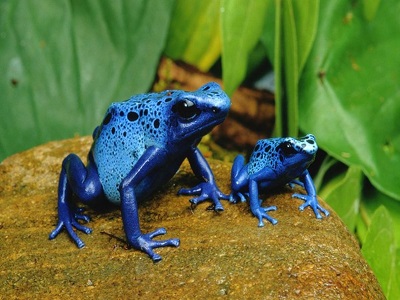
- Throughout their life cycles, frogs have an important place in the food chain as predators and prey. As tadpoles, they eat algae, which helps regulate blooms and reduces the chances of algae contamination. Frogs are an important food source for a variety of animals, including birds, fish, monkeys and snakes.
- The disappearance of frogs can disrupt an intricate food web with cascading effects felt across an entire ecosystem.
They are an indicator species.
- Frogs need suitable terrestrial and freshwater habitats to survive. They also have highly permeable skin that can easily absorb bacteria, chemicals, and other toxins. These traits make them susceptible to changes in the environment and great indicators of the health of their environment.

They keep insect populations in check.
Did we mention that frogs eat insects? These include pesky insects that most people don't want to deal with, as well as adult mosquitoes and their larvae that can transmit diseases such as dengue, malaria, West Nile fever and Zika.
Frogs are important in research.
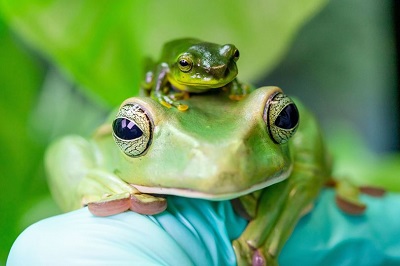
- Frogs have served as experimental animals throughout the history of science. They are used to understand biological phenomena in a variety of other animals, including how birds, mammals, and reptiles reproduce, grow, and develop.
- In the 1920s, the African clawed frog was used to determine if a woman is pregnant. After being injected with urine, if the frog produced eggs within 24 hours, the woman was pregnant. For Donnelly, frogs have provided a lifetime of discovery and opportunities to learn.
- Furthermore, frogs are the animals that are dissected the most in practical Biology classes at the high school. The arrangement of the frog's organs is resembles that of human beings. Its anatomy is also very useful for teaching about Evolution.
- Likewise, 11% of the scientific works that have led their authors to win the Nobel Prize in Medicine They have used frogs in experimentation. Frogs are a very popular research subject because ease of breeding and to manipulate them in the laboratory. Before tested on humans, many things are tested before on frogs.

Frogs are nature's pharmacy.
- Frogs don't just help in laboratory tests. They themselves are being used to create cures and research courses that are derived from its own biology. Frogs and amphibians are very hardy and adaptable. Some amphibians can regenerate your limbs, a capacity that science dreams of replicate in humans. Without frogs, this research window would close.
- Some poisonous frogs produce epibatidine, a painkiller 200 times more powerful than morphine. Unfortunately, people cannot safely ingest it because it is very toxic. But because frog toxins are so diverse, they are being investigated for their potential as therapeutic drugs.
- Frogs have been around for almost 300 million years, but are threatened by disease, pollution, habitat loss, invasive species and climate change. Their populations have declined dramatically since the 1950s and more than 120 species are thought to have already become extinct since the 1980s.
Fresh water would become toxic

- When the level of algae in the asweet gua rises too high, there is little oxygen, the ecosystem becomes toxic and the fish get sick and die.
- Amphibian tadpoles feed mainly on algae.
- Thus. If the frogs disappear, the bodies of water would fill of algae, affecting the entire biological chain.

Insects would drive us crazy
- The frogs keep the insect populations at tolerable levels since they eat flies, mosquitoes, moths, crickets and many other species.
- The super abundance of insects that would occur due to lack of frogs would be disastrous for crops food and would force the use of more pesticides.
Pandemic risks would increase

- With the natural predators of mosquitoes gone, would multiply malaria, dengue, Zika, encephalitis and other diseases.
- Although these diseases are not fatal if treated in time and effectively, the pressure on health systems would be so great that in practice they could become serious pandemics.

We would have less food
- The oldest record of human consumption of frogs It dates back to the XNUMXnd century in China.
- French monks ate frogs when they did not have fish on holy days.
- Currently, one billion tons of food are eaten in the world. frog legs per year.
Documentary about the importance of frogs
Why shouldn't you have frogs in the pool?
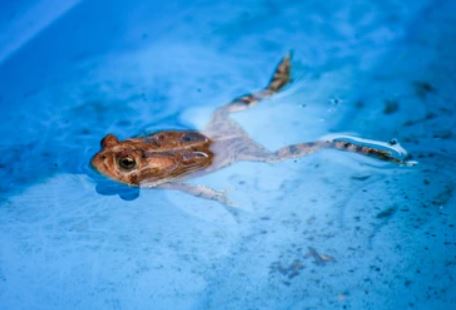
Health and Safety Reasons to Keep Frogs Out of the Pool
Disadvantages of frogs in the pool: They carry bacteria and diseases
- To begin with, clarify that frogs are wild animals that consequently contaminate our pool by transporting harmful contaminants and germs that can harm human health, such as salmonella.
Unfavorable point of frogs in the pool: they lay eggs in the water
- Frequently, and depending on the variety of frog, they can lay up to 50,000 eggs in our pool at one time.
- If you find a sticky cloud of frog eggs floating in your pool, your best bet is to fish it out with your skimmer net and put it in a body of fresh water.
- If you have a local pond or lake nearby, that would be ideal; Otherwise, you can place them in another container, away from your pool, since frogs are peaceful creatures that are actually very beneficial and our goal is not to kill them, we just want to keep them out of the pool.
Disadvantage of frogs in the pool: Their presence encourages the growth of algae
- A level It turns out that when tadpoles emerge from their eggs, they actually stir around in the water, causing a residue to form on top of the water.
- This residue has the unfortunate consequence of blocking sunlight from your pool and encouraging algae growth, despite the perfectly balanced chemicals you keep in your pool. While this is a huge boost to your natural ecosystems (i.e. a pond), it's probably the last thing you want to have to deal with in your pool.
- Below, in case it is of your interest, we provide you with the page where we develop how to get rid of green pool water.
How to get rid of frogs in the pool without harming them

Remove frogs from the pool without harming them
Methods to Get Rid of Pool Frogs Without Killing Them

- Place the mesh screen over your pool drain. The mesh netting should have holes small enough to prevent tadpoles from being sucked into the drain.
- Drain your pool until only a foot (30,48 centimeters) of water remains.
- Fill a 5-gallon (18,93 liter) bucket.
- Trap the tadpoles with a pool net to remove leaves. Drag the net behind the tadpoles and then lift the tadpoles on top.
- Hold the net over a 5-gallon (18,93 liter) bucket, then throw the tadpoles into the bucket. Continue removing the remaining tadpoles until you see no more.
- Drain the rest of the water from the pool.
- Refill the pool and keep it well chlorinated. Tadpoles cannot survive in well-chlorinated pools.
- How can I maintain safety in swimming pools?
- What are frogs?
- Taxonomy of Frogs
- Why do we need to protect frogs?
- Why shouldn't you have frogs in the pool?
- Avoid accidents with frogs and other animals in the pool
- Avoid accidents with the escape ramp save animals
- Inflatable frog pool
- pool toy frog
Avoid accidents with frogs and other animals in the pool

Why do frogs and other animals enter swimming pools?
Why do animals enter my pool?
Most animals probably get into pools by accident.
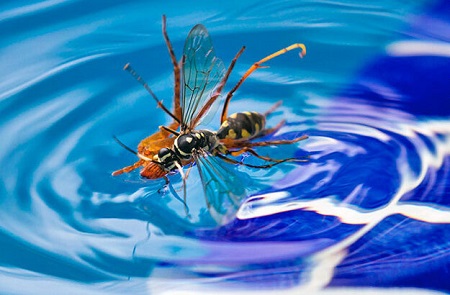
Although, some animals may be trying to drink and accidentally fall.
On the one hand, amphibians may enter pools due to their natural attraction to water or to reproduce.
Instead, toads and frogs may notice moths or other insects on the surface of the water and enter the pool to eat.
Why are there frogs in the pool?
In the event that there is only one frog in the pool
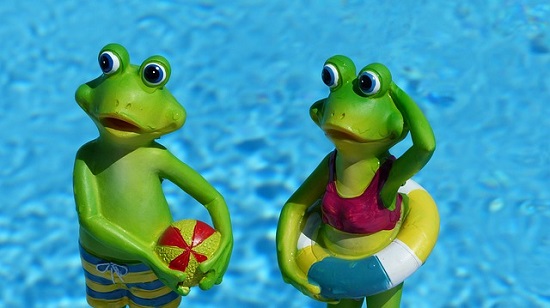
- Specifically, a frog gets into a pool moved by what we all move: food. In a pool, frogs have plenty of water to drink and insects that appear at night to stay well fed, so for them, it is a wonderful place to stay.
Why do frogs and salamanders die in my pool, aren't they aquatic animals?
Death of frogs and salamanders in the pool water
- First of all, amphibians (frogs, toads, salamanders) have permeable skin.
- From another angle, it is worth mentioning that chlorine will enter the bloodstream through its permeable skin.
- Besides. the salt water pools They are also toxic to amphibians.
How to keep frogs away from your pool
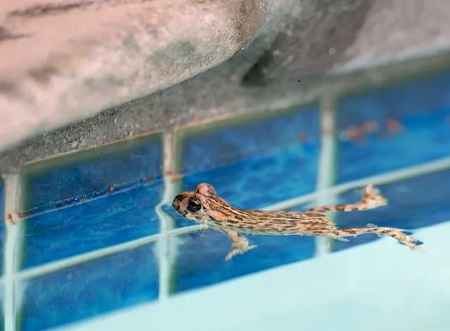
How can I reduce the incidences of finding animals in my pool?
Use a pool tarp
Use a tarp or cover
- A cover for your pool when it is not being used will prevent frogs, or any other insect, animal, etc. from sneaking into your pool. It's a good way to avoid unpleasant surprises.
- Make sure that the tarp covers the entire pool completely so that nothing or no one can accidentally fall into it.
- Place a pool cover over the pool at night and whenever you are not using the pool. This prevents insects or frogs from entering the pool.
- The cover should be easy to put on and close as completely as possible so that frogs, pets or small children cannot accidentally enter the pool and become trapped there.
Install a pool fence
anti frog fence
- A wooden or metal fence will prevent all types of animals from entering your pool area. Make sure the fence does not have cracks or holes as smaller frogs could sneak through them.
- A fence is the best defense against frogs. To keep frogs out of the pool, solid wooden or metal fences are very suitable. Wire fences or fences with holes should be avoided, as smaller frogs can squeeze their way through the openings.
Do not light the pool at night
Turn off the lights
- As we have already mentioned, lights at night are the biggest attraction for insects. And insects, the best banquet for frogs.
- Try to turn off the lights when it is not necessary, since with less lighting, there is less chance of insects and, therefore, you will avoid the frog call effect. Plus, you'll save money on your electricity bill!
- Pool lamps look great in the dark, but they also attract insects. Sooner or later the frogs will follow suit. It's best to turn off the lights when you don't want to use the pool or when you're not home anyway. When the pool and garden lighting is turned off, fewer insects and therefore fewer frogs reach the pool.
Heat the pool water
Cold Blooded Frogs – Hot Water Pool
- The frog is a cold-blooded animal, so it will not feel comfortable if it encounters water that is too hot. To achieve an adequate temperature, it is advisable to use a solar cover, which, on the one hand, heats the pool and, on the other, prevents animals from entering.
- As cold-blooded frogs, frogs need additional warmth, because they cannot maintain their own body temperature on their own. In fact, frogs avoid water that is too hot.
- We recommend using a solar cover. The cover serves two functions. On the one hand, it heats your pool and on the other hand, it prevents frogs from entering the pool, and the solar pool covers are easy to install and remove and work very well.
Keep pool water regularly filtered
Keep pool water recirculated
- Moving water through filtration is probably not enough for this.
- Another element that can help you is a waterfall or a water fountain that ensures movement in the pool water.
Make sure there is no standing water around the pool
- Your pool is definitely not the only source of water. You probably have birdbaths, boggy areas, water bowls, ponds, persistent puddles, or water retention in garden tools or car tires in your garden.
- Following this point, we must also avoid small puddles of water, low containers that have stagnant water, or any areas of humidity that attract toads and frogs. Stagnant water It's an open invitation. By preventing water from accumulating, you also avoid mosquitoes in the garden, but keep in mind, toads eat mosquitoes, so once you repel them, you can end up with an invasion of pestilent insects.
- Insects look for stagnant water to settle there. Insects like mosquitoes can only lay their eggs in the pool when the water is still. With a constant water cycle, it keeps the pool water moving and makes insects uncomfortable.
Provides an emergency exit for frogs in the pool
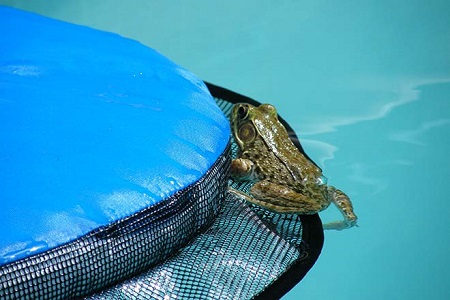
Provides an emergency exit for frogs in the pool
- Frogs occasionally fall into the pool water. The animals have enormous jumping power, but it is difficult to get out of the water over the edge of the pool. The result is that the frogs die of exhaustion and float dead in the water until the pool owners find them the next morning.
- It can be a simple board or a branch that rests on the edge of the pool and extends into the water.
- These driving ramps are a particularly practical solution. Frogs can easily get out of the water through this emergency exit. For large pools or pools with a more complex shape, it makes sense to place several of the escape ramps in the pool.
Remove weeds and debris from around the pool
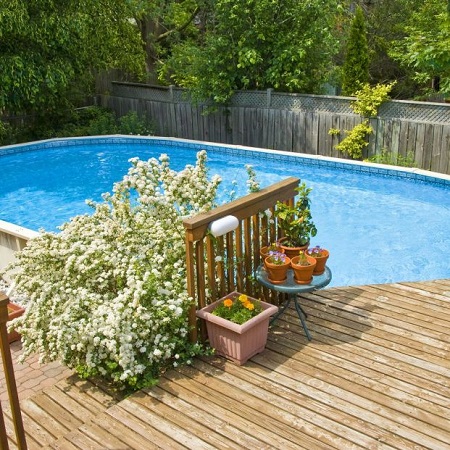
Remove weeds from around the pool
- A frog is enchanted among tall grasses, so if your garden has weeds, it will be an attractive place for it. Mow the grass regularly so that frogs cannot hide behind the grass.
- Like tall grass, bushes, and bushes, frogs use all types of trash as hiding places. Eliminate these hiding places by forcing them to live outdoors. So the frogs don't like that at all.
- Remove empty flower pots, old wood, stacked tables and chairs, old car tires, and almost anything that provides frogs with dark, damp shelter.
- Remove any piles of wood, old junk, or flower pots from the ground. Toads live in dark, damp places during the day and hunt at night. If their favorite places are taken away from them, they will have to go find shelter somewhere else.
Keep food and debris away
- Keep pet food inside the house. Toads know how to fend for themselves and your dog's food is free for them. Not only do they eat your pocket, they DO NOT eat the bugs in the garden. If you feed your pet outside the house, pick up leftover food at night.
- If you have pets, do not leave their food outdoors, where toads could access it. They find the food for your pets quite good, it is even more important to maintain this source of food out of the reach of the toads.
Keep insects away from the pool
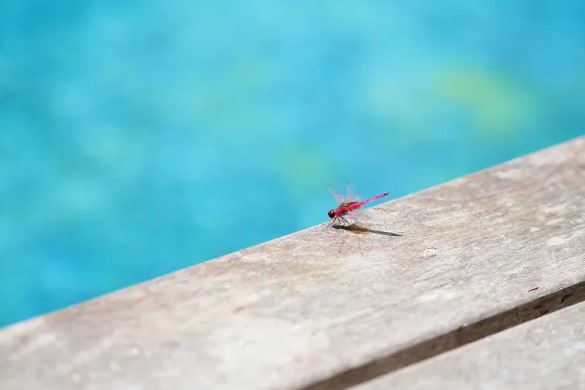
Eliminates insects
- As we have mentioned previously, insects are the essential food of frogs and toads. If they don't have their power source, it won't make sense for them to move around.
Repellents for frogs in the pool
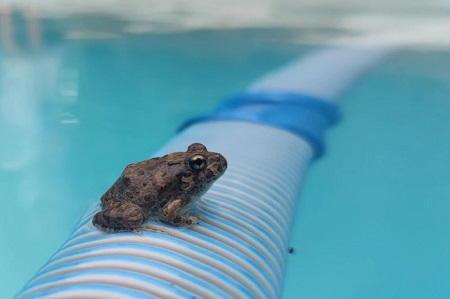
Herbicides
- One of the possible uses that can be given to herbicides is that there is evidence that suggests that certain herbicides can sterilize male frogs when they come into contact.
- This can reduce their population in the long term.
- However, you should find out about the species you will use it on, as its use on some species of toads and frogs is completely prohibited.
snake repellent
- While this may sound very strange, one of the best repellents for toads and frogs are those used on snakes. This method is the most recommended if you use chemicals, as it helps keep them off your property.
pesticides
- While its main use is to eliminate insects from your garden, however, Frogs that consume these insects can also be affected. Additionally, by removing their food source, the toads usually begin to emerge on their own.
Try using citrus acid to scare them away.
- This alternative is safer and more environmentally friendly. Use lemons, oranges, grapefruits or another fruit that is high in citric acid and spray the juice around the perimeter of the pool periodically.
Another natural repellent you can try is a salt solution with vinegar or instant coffee.
Toads in your pool? Follow these tips!
Tips to avoid having toads in the pool
Did you know that from a toad's point of view, a pool could be a very attractive place to take a dip. And if the pool attracts a large number of insects, this could become their main food resource. Below we present 8 recommendations that you could apply according to your need to keep toads out of the water.
Avoid accidents with the escape ramp save animals

What is the FrogLog pool animal saving ramp?
What types of animals can use the FrogLog pool animal rescue ramp?
- frogs, toads, salamanders, bees use FrogLog chipmunks, bats, small rabbits, squirrels use FrogLog ducklings, birds, mice, small hedgehogs use FrogLog lizards, snakes, small turtles, geckos use FrogLog
Does the FrogLog work as a ramp to save rabbits?
- The FrogLog has not been tested on rabbits. It has been tested on mice, squirrels, chipmunks and many other small animals. However, we have reports from several customers about not finding rabbits in their pool after adding FrogLogs.
Sometimes I still find very small dead toads in the pool when I use the froglog. because?
- Very small amphibians are very sensitive to chlorine. Adding multiple FrogLog units will reduce exposure time to chlorinated water and increase chances of survival.
Advantages exit ramp saves pool animals
Benefits exit ramp saves pool animals
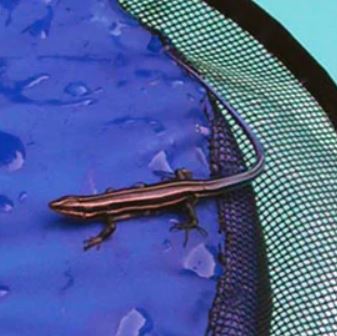
Obviously, this exit ramp saves all the wild animals that fall into the pool

Secondly, the animal rescue ramp contributes to having a clean and well-maintained pool guide.

The pool animal exit ramp helps reduce pool maintenance
FrogLog Operation
Use more than one FrogLog and increase the number higher and higher if:
- The pump and filter run at night.
- Chlorine levels remain high.
- The number of animals found in your pool is considerable.
- Small mammals (mice, chipmunks, etc.) are the main concern.
- There are multiple skimmer outlets in your pool.
How the FrogLog Animal Escape Ramp Works
Easy installation of FrogLog pool animal saver

FrogLog exit ramp for animals: assembly and placement
The FrogLog only takes a few minutes to set up and install.
- Open the flap on the rear edge of the floating platform. Squeeze the inflator nozzle onto the base and inflate the bladder to a firm consistency. Note: There is a fin inside the base of the mouthpiece that helps keep air in. This fin can stick and make it difficult for air to enter. If this occurs, use a small Phillips screwdriver or other small instrument and insert it into the nozzle to loosen the fin. Pinch the base again and inflate.
- Remove the small plastic bag from the cloth bag that has the FrogLog logo on it. Fill the bag with 1,5 to 2 cups of sand or gravel. Insert the plastic bag into the cloth bag. If you live in a windy area and find the sand is not heavy enough, replace some of the sand with small fishing weights to add more weight. Some customers have used dive belt weights inside the bag to add weight.
- Place the floating platform in the water and place the weighted bag on the pool cover. An optimal location is just upstream of the water flow moving toward the skimmer opening. Be sure to keep the back edge of the float against the pool wall. For multiple units, space the FrogLogs evenly around the pool.
- Cleaning and Repair
- Clean the FrogLog with warm soapy water. Dry the FrogLog before storing it. If it ever becomes punctured, the inflatable bladder can be removed and patched with a PVC patch kit. To remove the bladder, simply squeeze out the air and fold the edges toward the center so it can be removed through the opening.
How is the froglog different from the critter skimmer?
- The FrogLog can be placed anywhere around the pool deck and provides a quick escape route for animals.
- Multiple Froglog units can be placed around the pool to ensure animals escape quickly.
- The Critter Skimmer is an escape ramp that is placed inside the inlet of the skimmer. The animals have to enter the skimmer to escape.
- Unfortunately, animals may be exhausted or dead when they enter the skimmer.
- FrogLog and Critter Skimmer can be used together, especially if the pump and filter run at night.
How do I ensure the best efficiency of my froglogs?
- Make sure the back edge of the float is snug against the pool wall.
- Place the FrogLogs upstream of the water flow toward the skimmer intakes.
- Make sure the FrogLogs are always in the pool at night when most animals are active.
- Make sure the correct number of units is used based on the size of your pool.
How do I repair the inflatable bladder?
- Simply use a PVC repair kit that can be found at a hardware or pool store.
Then If you want more information about the product, we suggest that you click on the link to enter the official website of the FrogLog pool animal saver ramp.
Buy escape ramp save animals
Price of escape ramp saves animals FrogLog
[amazon box=»B004UHY2TY»]
Inflatable frog pool
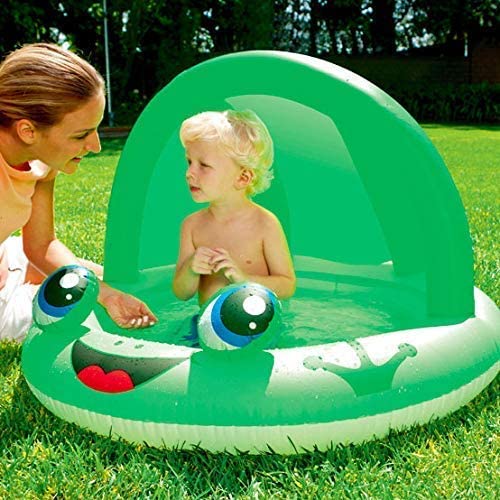
Buy Inflatable Frog Pool
Buy inflatable frog pool for babies green
[amazon box=”B08BCFD524″]
Buy red inflatable frog pool
[amazon box=»B08BCF6LBW»]
Inflatable Children's Pool with Ranasverde shading
[amazon box=»B088RFWD8S»]
RED Inflatable Children's Pool with red frogs shading
[amazon box=»B088RGZ3SG»]
Inflatable frog pool with sprinklers
[amazon box=»B08ZCSHWQP»]
BESTWAY Pool Float inflatable pool 100 x 83 cm frog shape
[amazon box=»B07BBNLYJX»]
pool toy frog

Buy toy frog for pool
Underwater Pool Toys Water Play Bottom Feeder for Kids
[amazon box=”B0B2NZ6LH6″]
4 Modes of Frog Pool Toy
[amazon box=”B09WCNHS31″]
Frog Pool Bath Toys
[amazon box=»B099ZDC5GS»]
Swimming Frog Children's Toy
[amazon box=”B09S8WLWT5″]
